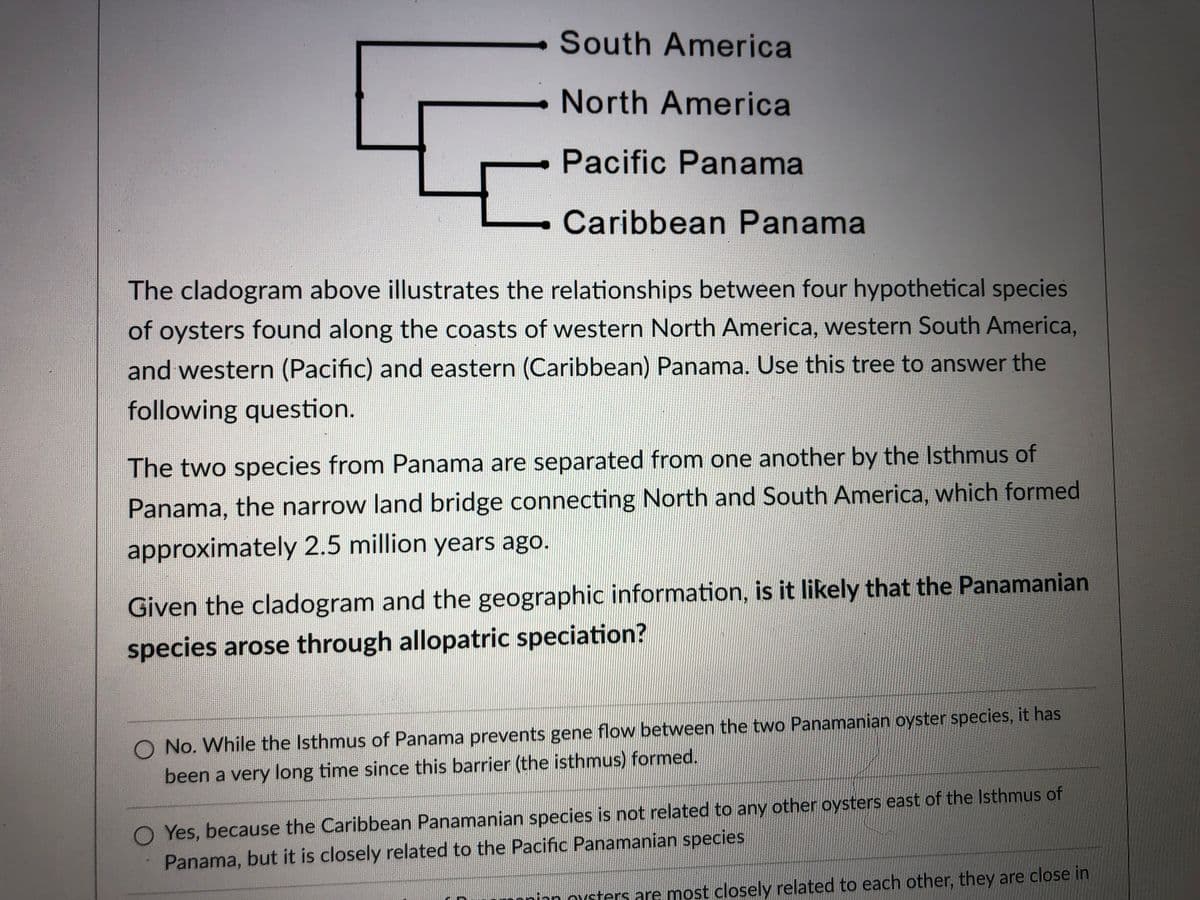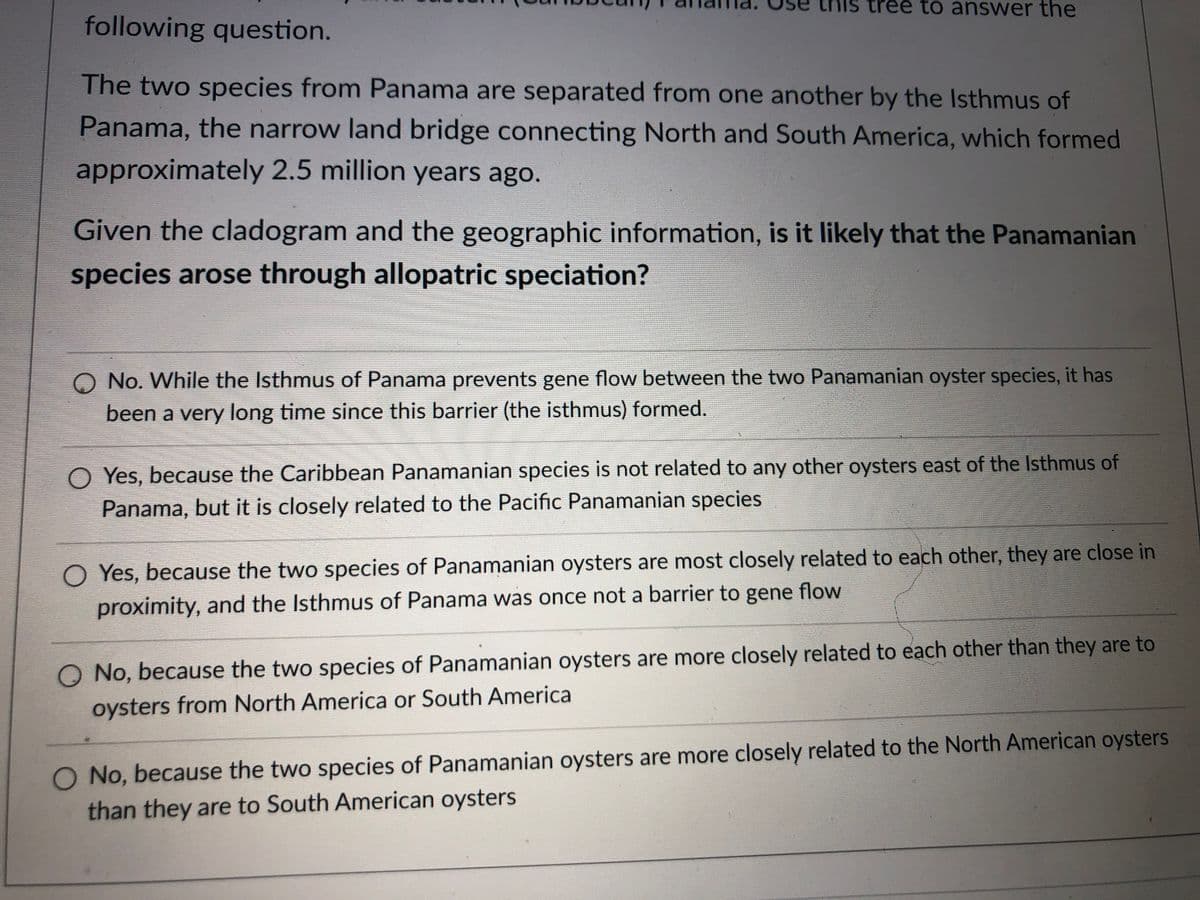Given the cladogram and the geographic information, is it likely that the Panamanian species arose through allopatric speciation? O No. While the Isthmus of Panama prevents gene flow between the two Panamanian oyster species, it has been a very long time since this barrier (the isthmus) formed. O Yes, because the Caribbean Panamanian species is not related to any other oysters east of the Isthmus of Panama, but it is closely related to the Pacific Panamanian species O Yes, because the two species of Panamanian oysters are most closely related to each other, they are close in proximity, and the Isthmus of Panama was once not a barrier to gene flow O No, because the two species of Panamanian oysters are more closely related to each other than they are to oysters from North America or South America O No, because the two species of Panamanian oysters are more closely related to the North American oysters than they are to South American oysters
Given the cladogram and the geographic information, is it likely that the Panamanian species arose through allopatric speciation? O No. While the Isthmus of Panama prevents gene flow between the two Panamanian oyster species, it has been a very long time since this barrier (the isthmus) formed. O Yes, because the Caribbean Panamanian species is not related to any other oysters east of the Isthmus of Panama, but it is closely related to the Pacific Panamanian species O Yes, because the two species of Panamanian oysters are most closely related to each other, they are close in proximity, and the Isthmus of Panama was once not a barrier to gene flow O No, because the two species of Panamanian oysters are more closely related to each other than they are to oysters from North America or South America O No, because the two species of Panamanian oysters are more closely related to the North American oysters than they are to South American oysters
Human Anatomy & Physiology (11th Edition)
11th Edition
ISBN:9780134580999
Author:Elaine N. Marieb, Katja N. Hoehn
Publisher:Elaine N. Marieb, Katja N. Hoehn
Chapter1: The Human Body: An Orientation
Section: Chapter Questions
Problem 1RQ: The correct sequence of levels forming the structural hierarchy is A. (a) organ, organ system,...
Related questions
Question

Transcribed Image Text:South America
North America
Pacific Panama
Caribbean Panama
The cladogram above illustrates the relationships between four hypothetical species
of oysters found along the coasts of western North America, western South America,
and western (Pacific) and eastern (Caribbean) Panama. Use this tree to answer the
following question.
The two species from Panama are separated from one another by the Isthmus of
Panama, the narrow land bridge connecting North and South America, which formed
approximately 2.5 million years ago.
Given the cladogram and the geographic information, is it likely that the Panamanian
species arose through allopatric speciation?
O No. While the Isthmus of Panama prevents gene flow between the two Panamanian oyster species, it has
been a very long time since this barrier (the isthmus) formed.
Yes, because the Caribbean Panamanian species is not related to any other oysters east of the Isthmus of
Panama, but it is closely related to the Pacific Panamanian species
nonian ovsters are most closely related to each other, they are close in

Transcribed Image Text:ree to answer the
following question.
The two species from Panama are separated from one another by the Isthmus of
Panama, the narrow land bridge connecting North and South America, which formed
approximately 2.5 million years ago.
Given the cladogram and the geographic information, is it likely that the Panamanian
species arose through allopatric speciation?
O No. While the Isthmus of Panama prevents gene flow between the two Panamanian oyster species, it has
been a very long time since this barrier (the isthmus) formed.
O Yes, because the Caribbean Panamanian species is not related to any other oysters east of the Isthmus of
Panama, but it is closely related to the Pacific Panamanian species
O Yes, because the two species of Panamanian oysters are most closely related to each other, they are close in
flow
proximity, and the Isthmus of Panama was once not a barrier to gene
O No, because the two species of Panamanian oysters are more closely related to each other than they are to
oysters from North America or South America
O No, because the two species of Panamanian oysters are more closely related to the North American oysters
than they are to South American oysters
Expert Solution
This question has been solved!
Explore an expertly crafted, step-by-step solution for a thorough understanding of key concepts.
This is a popular solution!
Trending now
This is a popular solution!
Step by step
Solved in 2 steps

Knowledge Booster
Learn more about
Need a deep-dive on the concept behind this application? Look no further. Learn more about this topic, biology and related others by exploring similar questions and additional content below.Recommended textbooks for you

Human Anatomy & Physiology (11th Edition)
Biology
ISBN:
9780134580999
Author:
Elaine N. Marieb, Katja N. Hoehn
Publisher:
PEARSON

Biology 2e
Biology
ISBN:
9781947172517
Author:
Matthew Douglas, Jung Choi, Mary Ann Clark
Publisher:
OpenStax

Anatomy & Physiology
Biology
ISBN:
9781259398629
Author:
McKinley, Michael P., O'loughlin, Valerie Dean, Bidle, Theresa Stouter
Publisher:
Mcgraw Hill Education,

Human Anatomy & Physiology (11th Edition)
Biology
ISBN:
9780134580999
Author:
Elaine N. Marieb, Katja N. Hoehn
Publisher:
PEARSON

Biology 2e
Biology
ISBN:
9781947172517
Author:
Matthew Douglas, Jung Choi, Mary Ann Clark
Publisher:
OpenStax

Anatomy & Physiology
Biology
ISBN:
9781259398629
Author:
McKinley, Michael P., O'loughlin, Valerie Dean, Bidle, Theresa Stouter
Publisher:
Mcgraw Hill Education,

Molecular Biology of the Cell (Sixth Edition)
Biology
ISBN:
9780815344322
Author:
Bruce Alberts, Alexander D. Johnson, Julian Lewis, David Morgan, Martin Raff, Keith Roberts, Peter Walter
Publisher:
W. W. Norton & Company

Laboratory Manual For Human Anatomy & Physiology
Biology
ISBN:
9781260159363
Author:
Martin, Terry R., Prentice-craver, Cynthia
Publisher:
McGraw-Hill Publishing Co.

Inquiry Into Life (16th Edition)
Biology
ISBN:
9781260231700
Author:
Sylvia S. Mader, Michael Windelspecht
Publisher:
McGraw Hill Education